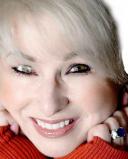Confidence
Change Your Hair, Change Your Life
When our hair thins or changes color, it can affect our self-confidence.
Posted May 30, 2019 Reviewed by Jessica Schrader
“Flow it. Show it. Long as God can grow it, my hair” –Hair (the musical)
Hair has been described as a woman’s crowning glory. It frames the face, either showing off its assets or liabilities. High cheekbones enable her to get away with a lot of different styles. A high forehead, not so much.

Psychology Today’s F. Diane Barth wrote about the importance of hair to our self-esteem in 2012. She writes, “I learned a long time ago that hair has meaning—lots of meaning. Growing up in the 1960s, my friends and siblings and I struggled with our parents for control over the length and style of our hair. At the time, hair represented our need to break free from the bonds that bound the tightly wound adults in our lives. Long tresses represented our freed inner selves and our goal of finding a way to live in peace with the rest of the world. Although we might have helped to end the war in Vietnam, we sadly didn’t achieve anything near world peace; and now many of us are fighting to keep just a little of the hair that once tumbled over our ears and down our backs.”
Having been alive as long as I have, there is no lack of opinion on my part about the topic—color, style, length, and appropriateness as we age. My views are not important ones, nor are they shared by all. But hair is something that—if we see it thinning or changing color—can be a cause for concern, affecting our sense of self-confidence.
Women adopt different styles and lengths as they enter each succeeding decade. Well, some do. I recall my ‘70s high school/most of college look very well: long hippie hair parted down the middle, which never was quite straight enough or shiny enough to please me. After spending a year in Europe, however, I came home and went directly to a hair salon, asking them to chop it all off in favor of a “shag” haircut, which hadn’t really hit the States at the time except in avant-garde hair magazines. Different lengths. Casual and fun. I learned to use a round brush with a handheld hair dryer strategically positioned to get the waves to fall correctly and to make my hair look fuller. Damn, that takes practice. And instead of my granny glasses, I sported the big Lucite frames I had seen on European girls. Until, of course, soft contact lenses came out, which I think are a modern miracle (along with jet travel).
By the ‘80s, I never let my hair grow longer than shoulder-length. With a little kid now in tow, I needed low maintenance as well as something I could scrunch into a ponytail. Even then my fine hair was difficult to manage (except for a short period of time when I did a permed, puffy Streisand “natural"). Since then, I have worn a lot of short styles, streaking my medium brown tresses blond here and there, and experimenting with bangs/no bangs until I found what worked for my face at the time.
Problem was, I hated staying the same. I still do. Once I found variations on a cut I liked, in my 50s I had started dying my hair a dark brown—something that suited my ethnic background and lent what I considered to be a certain "substantial quality" to my look. As I reached my 60s, however, the dark hair reminded me of the old Mediterranean ladies whose wrinkles never quite jived with their hair color. And when the wind blew my hair around with my convertible top down, passersby could too easily see my scalp, whose contrast is more evident with dark hair. I learned to sprinkle dark keratin fiber powder on my scalp to mask the issue, but this practice got really old.
Then I did something drastic. I went platinum. I gathered online photos of gorgeous women with Hollywood platinum hair, interviewed a few hair people to see whose approach floated my boat, chose one, closed my eyes and pulled the trigger. It was exciting. It was terrifying. And I wouldn't take back a moment of it except for the following: If you ever consider doing this, it takes most of the day. A warning: do not look in the mirror as the process is taking place because your hair is temporarily the color of a compost heap. With grey coming in around my face, it was either keep it dark or go blond, because the alternative was a mousy mix of faded gray and light brown — the reason my own mother had taken out stock in Lady Clairol. The final result was a shock to everyone who knew me, including myself each morning when I looked in the mirror. I learned then that with my new look I needed expert makeup advice as well, so I hightailed to the nearest Dior counter for some tips. God, I love those talented individuals who know (and show you) just what to do but are happy just selling you an eyeliner pencil because you can't afford more of their products at the time. Brows (whose ends began to disappear) also became more important so that I did not look like a woman in a Renaissance painting.
I think the point of this is to encourage women not to get frozen in time with their looks. Just because you looked great with long(er) hair in your 30s doesn’t mean it’s the best look into your 50s and 60s. But no one will tell you what might look better unless you ask. Are you open to new ideas, are you keeping your hair in a certain style just to please your spouse or your grown kids, or is your hair in a style you just can't budge from? You won't know what a big change will look like until you see it in the mirror and live with it for a while. If fear is at play here, face it and try something new. Hair grows. Color can be messed with and changed. And if you lose your nerve to try something new, you may also live with regrets that you never tried it. Going from longer to shorter hair can be very liberating—take it from me—as long as you keep your heart open to change, edginess and adventure.
While I did not ask for my husband’s approval, I did show him online photos of my intentions, telling him to brace himself. Now he loves it, claiming he married two different women that somehow sound and act the same. And I've gone shorter, which makes it even sassier. I have come to appreciate how the light color softens my look as my "earned wrinkles" continue to appear.
As Barth said, “Hair can also capture unrecognized and often unspoken daydreams about oneself and one’s world.” Don’t let your hair hold you back. Thin on top? Add a wig tuft topper. Or sprinkle that magic powder and watch as it begins to look magically fuller. Who cares if it’s smoke and mirrors as long as you like what you see in the mirror? And as Coco Chanel is famous for saying, “A woman who cuts her hair is about to change her life.”


